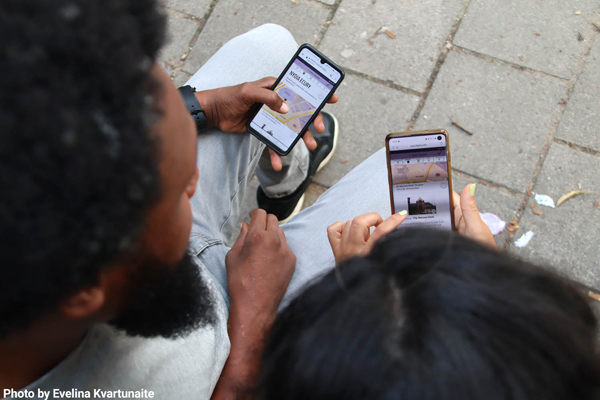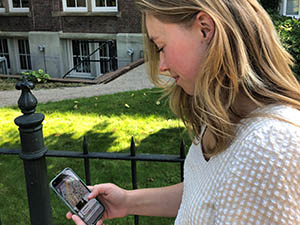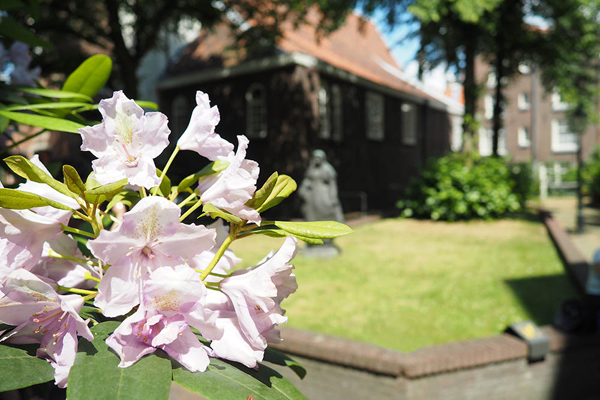A blog about (hidden) Amsterdam
A blog about (hidden) Amsterdam
The self-guided tour of Amsterdam was one of the unexpected results of the pandemic. With guidebooks, apps, or even PDFs, Amsterdammers of all stripes discovered facts that had been hidden in plain sight as they went about their city lives. We wanted our Badass Amsterdam DIY Tour to take that experience and make it into something special.
One advantage of our obsession with Amsterdam is that on every city walk, we see stories. Sometimes it’s something monumental. Our founder Elyzabeth, for example, usually refers to the Royal Palace as the Stadhuis, which it was in the 17th and 18th centuries. Sometimes it’s small things, like the hidden church where two Black 17th-century Amsterdammers married after a lifetime of wandering. Friends, relatives, and tour guests often enjoy hearing these hidden history asides as we walk along the historic waterways.

To share this experience of seeing stories everywhere, we needed a different approach than a normal tour. Most guides (us included) build tours by thinking about the key stories they want to tell, then finding places for them. That’s as true for mainstream tour guides who use the Spinoza statue to talk about tolerance as it is for us using a tower from the old city wall to talk about Gracia Mendes Nasi, who helped Jewish people flee the Portuguese and Spanish Inquisitions.

With our self-curated walking tour, we flipped the process. We wanted to create tours of Amsterdam neighborhoods that overlapped the history of major locations. So we started with Centrum, the oldest part of Amsterdam, and looked at the places that stand out, both now and across Amsterdam’s history. Dam Square and Nieuwmarkt are high points in any guidebook, many walk by the Kattengat or the Nes without any idea what their eyes are sliding over
Once we had a nice mix of sites that included highlights from the present and various points of the past, we started looking at the stories connected to them. For each location, we found stories from each of our themes: women, LGBTQ+, BIPOC, and Jewish people. (Read this article on why we use the term BIPOC.) This gave us an interesting mix of people who changed the world and people whose impact was more local.
Dirkje Kuik, who paved the way for trans people around the world, shares a stage with Mina Kruseman, a 19th-century actress who first promoted anticolonial writer Multatuli and then went to war with him. A single site holds Indonesian hero Surapati, the financial backer of the Dutch invasion of England, and a group of women whose names are as lost as their cause was. A 17th-century interfaith relationship rubs shoulders with 20th-century protests that brought down a homophobic law.
We ended up designing a different way to get a picture of Amsterdam. Where some tours will try to give a soft-edged photo of the city now, our self-guided tour of Amsterdam uses historical pointillism. Like Georges Seurat, the painter of A Sunday on La Grande Jatte, or Belgian pointillist Théo van Rysselberghe, we use many points to create an image. We try to show you the city by overlapping stories across centuries that tie to a single place, placing people whose names and actions still echo alongside those who struggled to get by.
We hope that between the giants and survivors of Amsterdam’s hidden history, you will catch a glimpse of what makes both Amsterdammers and the city we love so very special.

Check out some more Blamsterdam! posts.
Private Museum Tour
See the highlights and hidden icons of Amsterdam’s world-renowned Rijksmuseum in a private guided tour that explores who creates art and what stories it’s used to tell. And don’t worry about museum tickets. We’ve got you covered.


Small-Group Walking Tour
This historical tour through the busy Jewish quarter and residential Plantage neighborhood offers a selection of stories from BIPOC, LGBTQ+, Jewish and women’s history. It’s the perfect way to get an alternative view of Amsterdam.


Self-Guided Digital Tour
Use your phone to explore Amsterdam! This self-guided tour uses audio, images, maps, and text to introduce you to the women, BIPOC, LGBTQ+, and Jewish people who made Amsterdam what it is.


Small-Group Walking Tour
In 1593, Jewish Amsterdammers began building a community in the relative safety of the city that transformed both the Netherlands and the world. Learn about these creative, compassionate, and challenging mavericks and their impact.


Small-Group Walking Tour
The women who shaped Amsterdam are more complex than traditional tours would have you believe. Go to Amsterdam’s historic sites to hear stories of women who fought, wrote, calculated and led through the city’s chaotic and complicated past.


Small-Group Walking Tour
The world’s first gay marriage was officiated by the Mayor of Amsterdam at its City Hall. But did you know that the city’s LGBTQ+ history stretches centuries? Meet historical Amsterdammers across the gender spectrum and sexual orientations.


Private Walking Tour
Get a personalized tour that covers the interests you’re curious about and the neighborhoods you want to see. Choose pick-up/drop-off locations, any combination of our hidden history topics, and themes such as artists, politicians, and rebels.

